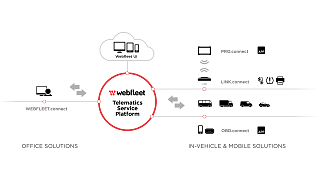With Webfleet you can work smarter across your entire organisation, not just the fleet. Unleash the power of fleet data to drive greater collaboration between teams and departments. With Webfleet’s open platform approach you can customise processes to suit your business or simply tap into the existing integrations we offer via our partner network.
Business integration: Key features and benefits
Boost applications
Benefit from a fully-connected fleet and workforce management solution.
Fast integration
Implement your solution quickly and easily.
Work smarter
Customise your workflow, both on the road and in the office.
Business integration features
Office solutions
Use WEBFLEET.connect to enrich your back-office systems with useful data from the road about your vehicles, jobs and workforce, including arrival times, working hours, mileage and more. Our Software and Hardware Alliance Partners offer off-the-shelf integration with dozens of your applications.


In-vehicle solutions
We connect your vehicles to your office. And since we already established this connection we want to enable you to connect other devices to your back-office using LINK.connect. Allow 3rd party hardware to talk to your TomTom LINK tracking device via Bluetooth to capture additional data from in and around the vehicle, such as temperature sensors, tyre pressure, barcode scanning and RFID.
Business apps
With our PRO 8 devices we digitise the life of your mobile workforce, making it easier for everyone to be informed and up-to-date.
But that’s not enough we thought. We want you to be able to run your specific business applications as well. Hence we created PRO.connect, an API with which you can integrate Apps on the PRO 8 with your own back end systems.
Learn more about PRO 8
Webfleet APIs
TomTom has three powerful APIs to help you boost your business.
WEBFLEET.connect
Integrate Webfleet with your office applications.
LINK.connect
Connect with 3rd party Bluetooth devices, and transmit data from the field to your back office.
PRO.connect
Use mobile apps on the PRO 8 driver terminal to digitalise every step of the workflow.
All you need to know about fleet management integrations
What is a business integration?
0
What is a business integration?
0Business integration refers to the process of combining different parts or aspects of a business to harmonise operations. It involves integrating various systems, processes, functions and departments within an organisation to improve efficiency and achieve shared goals. Business integration can take place within a single company or across multiple organisations involved in a merger, acquisition or strategic partnership.
What is an API integration?
0
What is an API integration?
0API integrations connect and combine software applications or systems using Application Programming Interfaces, or APIs. API integrations enable seamless data sharing and functionality between disparate systems, applications or platforms. Such an integration allows a business to leverage the capabilities of third-party services, access external data sources and automate processes by integrating various software components.
What is cloud integration?
0
What is cloud integration?
0Cloud integration combines cloud-based applications, platforms or services so they work together and share data seamlessly. It eliminates the need for manual data transfers or synchronization between disparate systems, since real-time data sharing and collaboration are a key feature of cloud integrations.
What is an ERP system integration?
0
What is an ERP system integration?
0An enterprise resource planning (ERP) integration allows an organisation to connect its ERP system with other systems or software applications. ERP systems are comprehensive software solutions that manage and integrate various business processes within fleet management, from finance and human resources to customer relationship management. Fleet data can flow seamlessly, eliminating information silos and reducing manual administration. ERP integrations ensure data consistency and accuracy across various fleet departments or roles.
What are fleet management integrations?
0
What are fleet management integrations?
0Bridging a fleet management system with software applications or platforms makes up a fleet management integration. The purpose is to enhance fleet efficiency and improve business decision making around vehicle, fuel and driver management. Fleet management integrations also simplify asset monitoring and business reporting.
How do business integrations for fleets work?
0
How do business integrations for fleets work?
0Business integrations for fleets deliver ready-made solutions that streamline back-office processes. Fleet operators can therefore connect their in-vehicle and mobile tools to their office administration. For example, a fleet can enable third-party hardware to communicate with the company’s GPS tracking devices to collect vehicle data. Webfleet’s partnership with Chargylize even helps fleets determine their electrification potential.
What are the benefits of business integrations for fleets?
0
What are the benefits of business integrations for fleets?
0Business integrations make it easy for fleets to use various third-party solutions while managing their operations on a single platform. Webfleet takes an open approach to integrations, meaning that fleets have the flexibility to customise the processes that will work best for their business.
Your consent is required
In this section, external content is being embedded from .
To display the content, your consent is required for the following cookie categories:
- Targeted Advertising
- Analytics
- Personalization
- Essential
For further details, please refer to our privacy policy. If you are interested in how ###vendor_name### processes your data, please visit their privacy policy.








